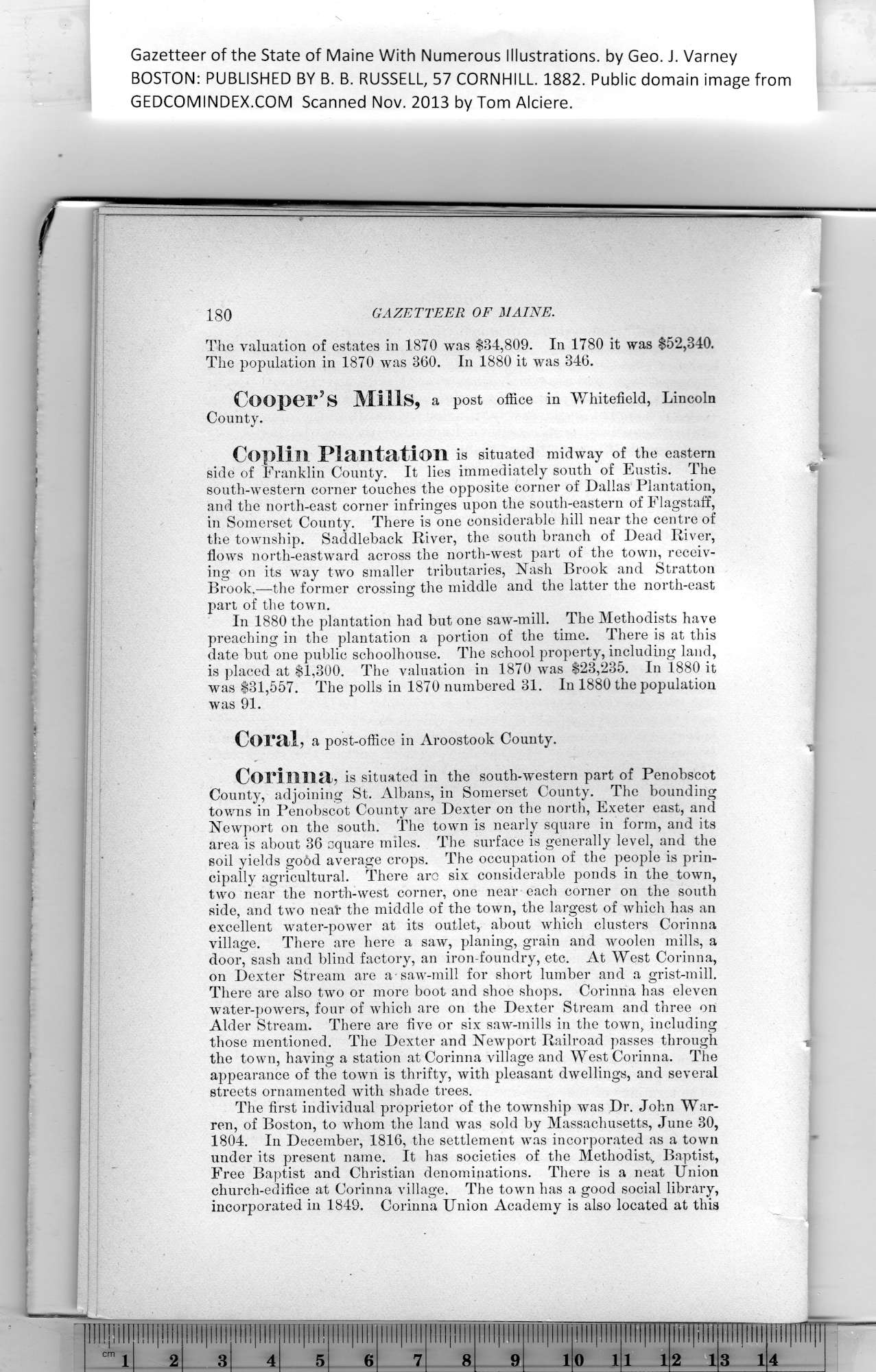|
Gazetteer of the State of Maine With Numerous Illustrations, by Geo. J. Varney
BOSTON: PUBLISHED BY B. B. RUSSELL, 57 CORNHILL. 1882. Public domain image from
180 GAZETTEER OF MAINE.
The valuation of estates in 1870 was $34,809. In 1780 it was $52,340.
The population in 1870 was 360. In 1880 it was 346.
Cooper’s Mills, a post office in Whitefield, Lincoln
County.
Coplin Plantation is situated midway of the eastern
side of Franklin County. It lies immediately south of Eustis. The
south-western corner touches the opposite corner of Dallas Plantation,
and the north-east corner infringes upon the south-eastern of Flagstaff,
in Somerset County. There is one considerable hill near the centre of
the township. Saddleback River, the south branch of Dead River,
flows north-eastward across the north-west part of the town, receiv-
ing on its way two smaller tributaries, Nash Brook and Stratton
Brook.—the former crossing the middle and the latter the north-east
part of the town.
In 1880 the plantation had but one saw-mill. Tbe Methodists have
preaching in the plantation a portion of the time. There is at this
date but one public schoolhouse. The school property, including land,
is placed at $1,300. The valuation in 1870 was $23,235. In 1880 it
was $31,557. The polls in 1870 numbered 31. In 1880 the population
was 91.
Coral, a post-office in Aroostook County.
Corinna, is situated in the south-western part of Penobscot
County, adjoining St. Albans, in Somerset County. The bounding
towns in Penobscot County are Dexter on the north, Exeter east, and
Newport on the south. The town is nearly square in form, and its
area is about 36 square miles. The surface is generally level, aiid the
soil yields good average crops. The occupation of the people is prin-
cipally agricultural. There are six considerable ponds in the town,
two near the north-west corner, one near each corner on the south
side, and two near the middle of the town, the largest of which has an
excellent water-power at its outlet, about which clusters Corinna
village. There are here a saw, planing, grain and woolen mills, a
door, sash and blind factory, an iron-foundry, etc. At West Corinna,
on Dexter Stream are a -saw-mill for short lumber and a grist-mill.
There are also two or more boot and shoe shops. Corinna has eleven
water-powers, four of which are on the Dexter Stream and three on
Alder Stream. There are five or six saw-mills in the town, including
those mentioned. The Dexter and Newport Railroad passes through
the town, having a station at Corinna village and West Corinna. The
appearance of the town is thrifty, with pleasant dwellings, and several
streets ornamented with shade trees.
The first individual j>roprietor of the township was Dr. John War-
ren, of Boston, to whom the land was sold by Massachusetts, June 30,
1804. In December, 1816, the settlement was incorporated as a town
under its present name. It has societies of the Methodist, Baptist,
Free Baptist and Christian denominations. There is a neat Union
church-edifice at Corinna village. The town has a good social library,
incorporated in 1849. Corinna Union Academy is also located at this
PREVIOUS PAGE ... NEXT PAGE
This page was written in HTML using a program written in Python 3.2
|
